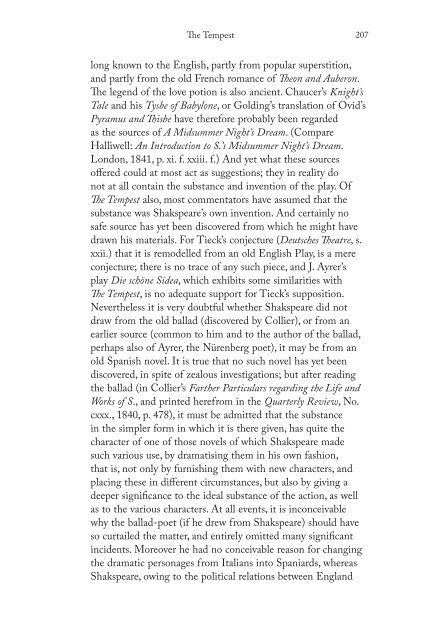Blooms Literary Themes - THE TRICKSTER.pdf - ymerleksi - home
Blooms Literary Themes - THE TRICKSTER.pdf - ymerleksi - home
Blooms Literary Themes - THE TRICKSTER.pdf - ymerleksi - home
You also want an ePaper? Increase the reach of your titles
YUMPU automatically turns print PDFs into web optimized ePapers that Google loves.
Th e Tempest 207<br />
long known to the English, partly from popular superstition,<br />
and partly from the old French romance of Th eon and Auberon.<br />
Th e legend of the love potion is also ancient. Chaucer’s Knight’s<br />
Tale and his Tysbe of Babylone, or Golding’s translation of Ovid’s<br />
Pyramus and Th isbe have therefore probably been regarded<br />
as the sources of A Midsummer Night’s Dream. (Compare<br />
Halliwell: An Introduction to S.’s Midsummer Night’s Dream.<br />
London, 1841, p. xi. f. xxiii. f.) And yet what these sources<br />
off ered could at most act as suggestions; they in reality do<br />
not at all contain the substance and invention of the play. Of<br />
Th e Tempest also, most commentators have assumed that the<br />
substance was Shakspeare’s own invention. And certainly no<br />
safe source has yet been discovered from which he might have<br />
drawn his materials. For Tieck’s conjecture (Deutsches Th eatre, s.<br />
xxii.) that it is remodelled from an old English Play, is a mere<br />
conjecture; there is no trace of any such piece, and J. Ayrer’s<br />
play Die schöne Sidea, which exhibits some similarities with<br />
Th e Tempest, is no adequate support for Tieck’s supposition.<br />
Nevertheless it is very doubtful whether Shakspeare did not<br />
draw from the old ballad (discovered by Collier), or from an<br />
earlier source (common to him and to the author of the ballad,<br />
perhaps also of Ayrer, the Nürenberg poet), it may be from an<br />
old Spanish novel. It is true that no such novel has yet been<br />
discovered, in spite of zealous investigations; but after reading<br />
the ballad (in Collier’s Farther Particulars regarding the Life and<br />
Works of S., and printed herefrom in the Quarterly Review, No.<br />
cxxx., 1840, p. 478), it must be admitted that the substance<br />
in the simpler form in which it is there given, has quite the<br />
character of one of those novels of which Shakspeare made<br />
such various use, by dramatising them in his own fashion,<br />
that is, not only by furnishing them with new characters, and<br />
placing these in diff erent circumstances, but also by giving a<br />
deeper signifi cance to the ideal substance of the action, as well<br />
as to the various characters. At all events, it is inconceivable<br />
why the ballad-poet (if he drew from Shakspeare) should have<br />
so curtailed the matter, and entirely omitted many signifi cant<br />
incidents. Moreover he had no conceivable reason for changing<br />
the dramatic personages from Italians into Spaniards, whereas<br />
Shakspeare, owing to the political relations between England

















